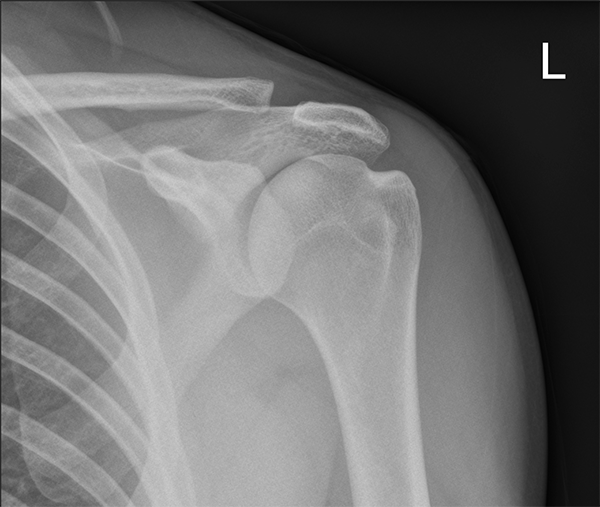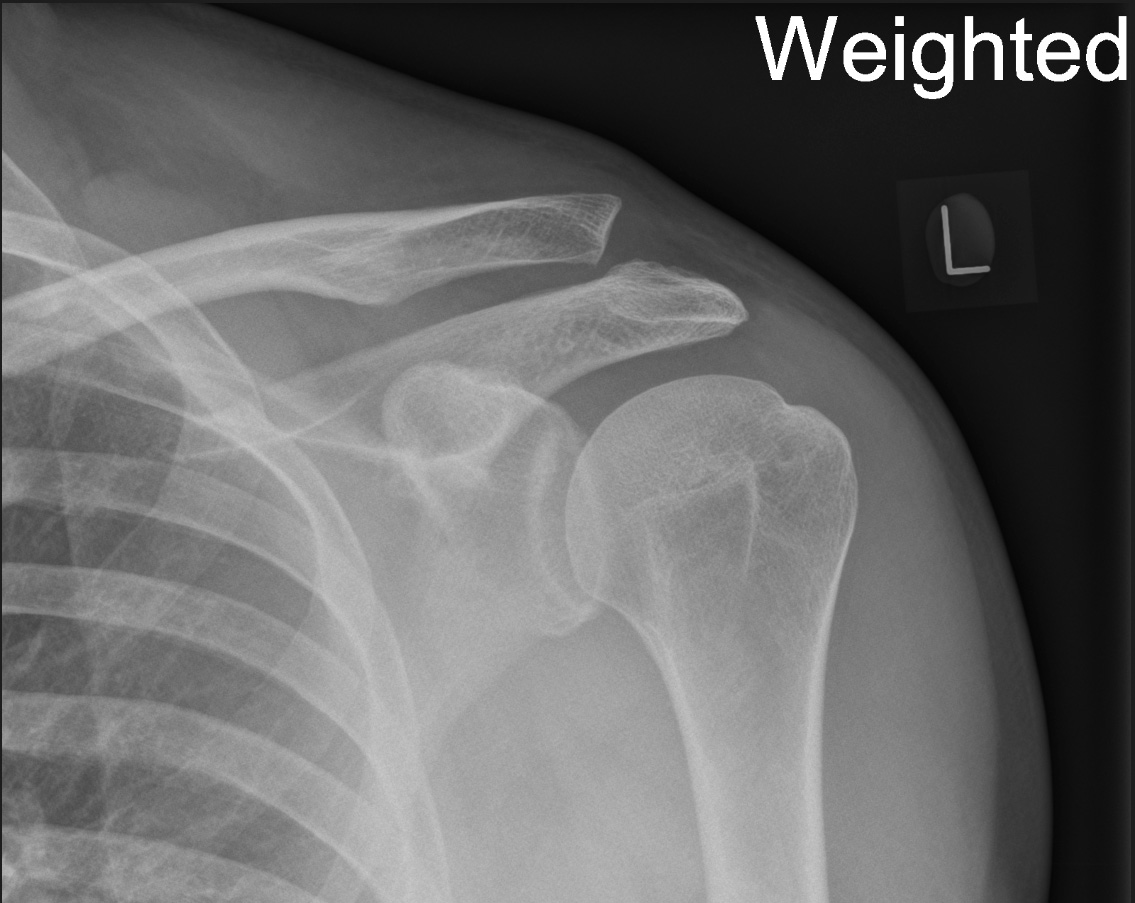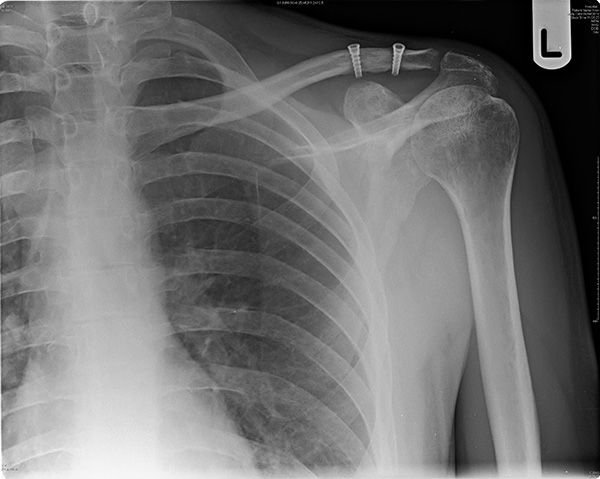What are acromioclavicular joint (ACJ) injuries?
The acromioclavicular joint is found the on the top of the shoulder and is formed between the collarbone (clavicle) and the acromion, which is part of the shoulder blade.The ACJ can be injured either acutely following an injury or chronically over time due to wear and tear.
Acute disruption to the ACJ occurs when people fall directly onto the point of the shoulder. Injuries are seen in sports such as rugby, martial arts and horse riding. The shoulder and arm are forced away from the collarbone and the soft tissue ligaments that support and provide stability to the joint are damaged. The extent of the injury can be graded according to its severity and this will determine the treatment.
What are the signs and symptoms?
Gradual wear and tear of the ACJ can lead to chronic pain and degeneration of the joint. Pain is felt over the top of the shoulder and often patients can point with one finger to site if the problem.
ACJ Grade 2
How are ACJ injuries diagnosed?
A clinical history of fall onto the point of the shoulder is common. There may be disruption to the ACJ with a “lump” noticed at the end of the collarbone. An X-ray will confirm the diagnosis.ACJ injuries are then graded according to the position of the collarbone in relation to the acromium as seen on X-ray. In mild injuries there is little or no displacement of the joint (Grade 1 or 2). Further displacement of joint, equivalent to 100% separation, is grade 3. More than 100% is graded as 5. Grade 4 relates to backward (posterior) displacement and Grade 6 is almost never seen.
How are ACJ injuries treated?
Most grade 1 or 2 injuries will settle with time, painkillers, ice and rest.The treatment of grade 3 injuries remains controversial. Most grade 3 injuries will settle with conservative management over a period of three months. If the joint remains symptomatic and unstable following a period of non-surgical treatment, surgery to reconstruct the ACJ can be performed.
Surgery is generally recommended for ACJ separation grades 4-6.
There are many techniques described to repair or reconstruct the ACJ. The aim of surgery in acute injuries, treated within a few weeks, is to re-approximate the torn ligaments and to protect the repair while healing takes place. In chronic disruption (weeks to months after injury) a ligament reconstruction with either an artificial ligament or tendon graft will be required. Surgery may be performed open (through a skin incision) or with keyhole (arthroscopic) assistance.
What are the potential complications?
The risks of surgery are low, with very low risks of infection, bleeding and nerve injury. There is a small risk of shoulder stiffness, which generally improves with time. There is a small risk of failure of fixation, most likely in the early stages after repair, if the rehabilitation is not followed.What rehabilitation is necessary after surgery?
A sling is required for three to six weeks depending on the procedure and individual circumstances. The patient will be seen by a physiotherapist within a week of surgery to start controlled movements of the shoulder before progressing through a rehabilitation programme. Driving can resume after six weeks and return to contact sports at three months.
ACJ Grade 3

AP ACJ dislocation post-op stabilisation
Testimonials
A big thank you to Simon and his team for their care, patience and perseverence looking after me through all stages of both shoulder and elbow surgery.
Since the shoulder stabilisation I have continued my sailing and fitness training without the worry that my shoulder might dislocate; and I don’t have to think twice whether my ulnar nerve will hinder any progression in my sports.
With their amazing help, I’ve been able to get back to sailing competatively and am now a double National champion.
After multiple shoulder dislocations Charlie helped me set a route for recovery, which has been nothing but smooth sailing. Surgery went successfully and I am well on my way to playing the sports I was previously. Would highly recommend.
Simon successfully operated on my frozen left shoulder in 2012 with fantastic results. This year he has overseen and advised treatment for my frozen right shoulder (via hydrodilation injection). His unrivalled experience in orthopaedic shoulder treatments, coupled with his reassuring bedside manner and excellent results, gave me huge confidence throughout. I’m hugely grateful to have my quality of life back and wouldn’t hesitate to recommend his services. Thank you Simon.
I had suffered with a painful shoulder and pins and needles for three years following a right shoulder fracture and failed half joint replacement prior to meeting Mr Pennington. He explained the situation in a way I could relate to and I’m delighted to say my revision shoulder replacement has gone well and for the first time in years I can use my arm and am pain free. I was even able to walk my daughter down the aisle 3 months after surgery! Many thanks.
I would like to thank Charlie Talbot and his team for the operations performed on both my shoulders and also the aftercare put in place after my operations. I have played golf since I was 12 years of age and thought at one point that I would never get back to playing again. Charlie was always very positive and told me that he would get me playing golf again. Well, I have now been playing golf for nearly 2 years. Before surgery I had a handicap of 12 and I am now down to 9, not bad at the age of 68. So many many thanks.
I had PRP injections into my right elbow last year and within 3 months I was pain free, a year on it is more or less 100% better. Fabulous I would recommend it to anyone with Tennis Elbow, in fact I have gone back again this year to get my left elbow done. Thanks Simon.
Mr Pennington I really wanted you to know how very thankful I am for the excellent care & treatment you and your staff gave me. It really meant a lot that you were so clear, friendly & professional and listened to me – so thank you again.
After more than four decades of shoulder problems with a total of three surgeries the full shoulder replacement surgery by Mr. Talbot has changed my life beyond expectations. I am now able bodied for the first time in years and pain free.
Thank you to Mr Boyle and team for the excellent care and attention both before and after Replacement Shoulder surgery, using the Tornier Simpliciti procedure. After very many months of severe pain and lack of movement I was pain free from day one. Now, after nine weeks, the shoulder and arm movement continues to improve, beyond expectation, with physiotherapy and exercise. I am extremely grateful for all the continuing care.
Following two years of recurrent problems with my left shoulder I was recommendedto Consult Mr Neil Pennington. I had the opportunity to have my surgery quickly and at my convenience, this fitted well around my professional and home commitments. The surgery was carried out as a day case procedure and Mr Pennington visited me following the surgery to explain everything. My operation was a minimally invasive procedure so my recovery was straightforward with only a few restrictions; in fact I was encouraged to keep my shoulder moving. I was driving and back to work after 2 weeks – after 2 years of pain and sleep disturbance I found this operation to be life changing! I found Mr Pennington to be a very professional and compassionate surgeon and he is surrounded by a whole team of professionals that gave me the utmost confidence in the care and treatment I received.
I would like to thank Mr. Talbot and the amazing team of nurses, physiotherapists and support staff for their care and support during my recent visit to the Duchy Hospital, Harrogate, for a replacement shoulder. The care and attention I received was unparalleled. The pain free movement I now have has changed my life.


